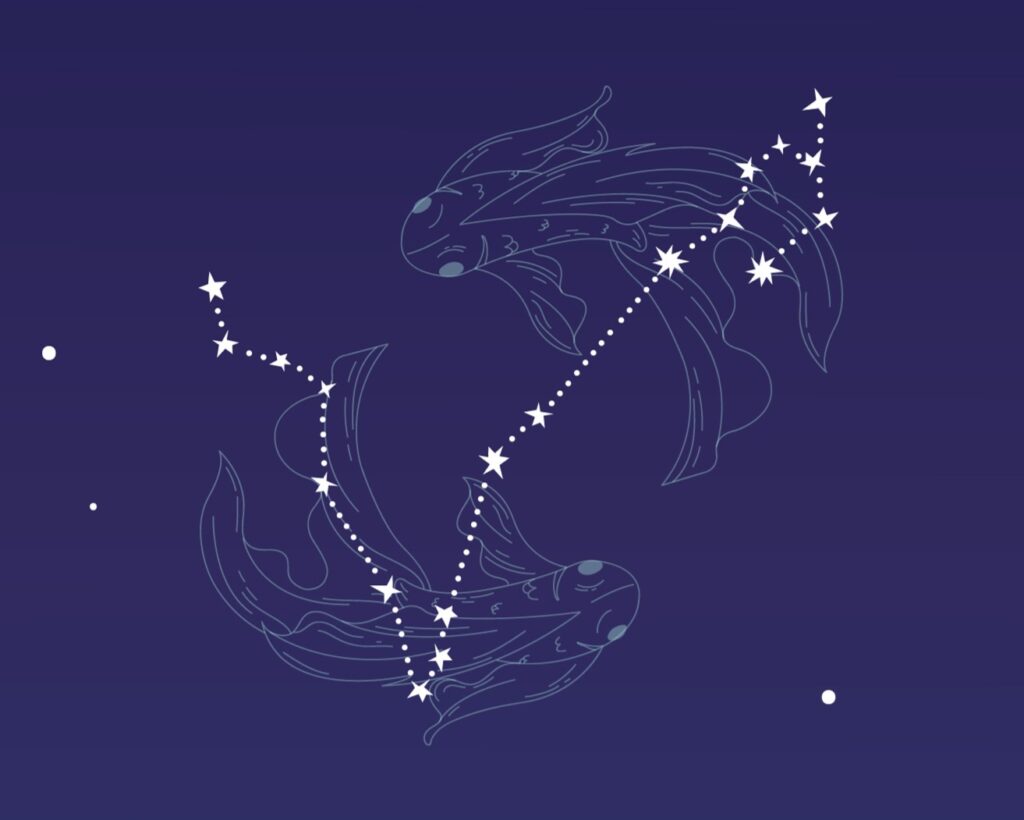Stargazing with Pisces
© freepik/tartila
Table of Contents
The Pisces constellation, one of the 88 officially recognized constellations, unfolds a celestial narrative in the vast night sky. Positioned between the similar-sized Aquarius to the southwest and the smaller Aries to the east, Pisces holds a special place in the cosmic arrangement. The intersection of the ecliptic and the celestial equator occurs within this constellation, as well as in Virgo. This unique alignment signifies that, on average, the Sun traverses the sky directly above the equator around this point during the March equinox, casting its celestial influence on the constellation.
Its name is rooted in ancient Greek mythology, representing two fish tied together by a cord, symbolizing the escape of Aphrodite and her son Eros from the monster Typhon. Pisces holds significance in various cultures and is associated with stories of love, escape, and transformation. With its diverse collection of stars and deep-sky objects, the constellation beckons skywatchers to explore the mysteries of the universe and connect with the rich mythological narratives embedded in its twinkling embrace.
HISTORY OF PISCES

The constellation has a rich history dating back to ancient times, as it is one of the twelve zodiacal constellations recognized in Western astrology. The name “Pisces” is Latin for fish, and its association with fish is deeply rooted in mythology.
In Greek mythology, Pisces is often linked to the story of Aphrodite and her son Eros. According to the myth, the two transformed into fish to escape the monstrous Typhon, who sought to destroy the gods. The cord that binds the fish in the constellation represents the symbolic connection between Aphrodite and Eros as they fled to safety.
The Babylonians also incorporated Pisces into their celestial observations. They associated the constellation with the goddess Anunitum, depicted as a woman holding a vase from which water flowed, reinforcing the watery theme associated with fish.
In ancient Hindu astronomy, the constellation is identified as the constellation “Mina,” representing the fish. The story in Hindu mythology involves the god Vishnu transforming into a fish, Matsya, to save the sacred scriptures and the sage Manu from a deluge.
The significance of the constellation continued into Roman culture, where it became one of the twelve zodiac signs. The period when the Sun passes through Pisces, known as the Pisces season, typically falls between February 19 and March 20 in the tropical zodiac.
ASTRONOMICAL FEATURES

The Pisces constellation, though not particularly prominent in terms of bright stars, possesses several notable celestial features and deep-sky objects that add to its astronomical allure.
MESSIER 74
Messier 74, also known as the Phantom Galaxy, is a stunning face-on spiral galaxy located in the Pisces constellation. This celestial beauty is recognized for its grand spiral arms that swirl outward from its bright core, creating a mesmerizing visual display.
Discovered by the French astronomer Pierre Méchain in 1780, Messier 74 was later added to Charles Messier’s famous catalogue of celestial objects. Situated about 32 million light-years away from Earth, this galaxy serves as an exquisite example of a spiral galaxy and attracts the attention of astronomers and stargazers alike. While not as prominent as some other objects in the Messier catalogue, the intricate structure and distant allure of Messier 74 make it a captivating target for those exploring the wonders of the deep sky.
PISCES DWARF
The Pisces Dwarf, designated as LGS 3, is a dwarf irregular galaxy that resides in the constellation. As a member of the Local Group, a collection of galaxies that includes our Milky Way, the Pisces Dwarf contributes to the cosmic diversity of our galactic neighbourhood. Discovered in the early 2000s, dwarf galaxies like LGS 3 are essential in studying the broader structure and dynamics of the universe.
Despite their modest size and luminosity, these celestial entities play a crucial role in our understanding of galactic evolution and the intricate dance of gravitational interactions within the cosmic tapestry. The Pisces Dwarf adds a subtle yet significant element to the night sky, enriching our exploration of the vast celestial landscapes beyond our own galaxy.
THE CIRCLET
The Circlet, also known as the “Pisces Circlet,” is an asterism formed by a distinctive arrangement of stars within the constellation. Comprising a loop or circle-like pattern, the Circlet is a notable feature in the celestial expanse. Positioned near the western part of Pisces, this stellar arrangement adds a touch of visual elegance to the night sky. While Pisces itself is associated with two fish tied together by a cord, the Circlet enhances the constellation’s visual allure with its recognizable circular configuration. Stargazers and astronomers often appreciate the celestial aesthetics brought about by asterisms like the Pisces Circlet, contributing to the charm and fascination of the cosmic tableau.
NGC 488
NGC 488 is a spiral galaxy located in the Pisces constellation. Positioned approximately 90 million light-years away from Earth, this distant galaxy showcases intricate spiral arms that wind outward from its bright central core. Discovered in 1863 by the German astronomer Heinrich d’Arrest, NGC 488 is a captivating celestial object that contributes to our understanding of galactic structures and formations. While its visual appearance might be modest compared to some other galaxies, the study of galaxies like NGC 488 provides valuable insights into the vast and diverse cosmic landscape, allowing astronomers to unravel the mysteries of the universe.
NGC 520
NGC 520 is a peculiar galaxy located in the Pisces constellation. This interacting pair of galaxies, often referred to as a merger system, is undergoing a gravitational dance that results in distorted and elongated structures. The interaction has triggered intense star formation within NGC 520, leading to the formation of bright knots and intricate patterns of gas and dust.
Discovered in 1878 by the French astronomer Édouard Stephan, NGC 520 provides astronomers with valuable insights into the complex processes involved in galactic interactions and the subsequent evolution of celestial objects.
PISCES II DWARF GALAXY
Pisces II Dwarf Galaxy, designated as Psc II, is a faint and diminutive member of the Local Group of galaxies, situated in the constellation. Discovered through data from the Sloan Digital Sky Survey in 2007, this dwarf galaxy is characterized by its low luminosity and sparse stellar population.
As one of the numerous small galactic companions surrounding the Milky Way, Pisces II contributes to the broader understanding of the galactic structure and the dynamics of the cosmic neighbourhood. The study of such dwarf galaxies aids astronomers in unravelling the complexities of galactic evolution and the interactions that shape the vast cosmic tapestry. Though faint in the night sky, this Dwarf Galaxy adds a subtle yet significant element to our exploration of the celestial realms beyond our own Milky Way.
VISIBILITY AND SEASONALITY

The Pisces constellation, positioned in the northern celestial hemisphere, offers a unique celestial panorama. Known for its association with two mythological fish tied together by a cord, it graces the night sky during specific seasons, captivating stargazers with its subtle brilliance. Understanding the visibility and seasonality of the constellation allows observers to appreciate its celestial wonders and explore the deep-sky objects embedded within its cosmic embrace. Let’s delve into the intriguing patterns and optimal viewing times that characterize the presence of Pisces in the celestial expanse.
NORTHERN HEMISPHERE
- Spring: Pisces is well-placed for observation during spring, appearing in the western evening sky. It reaches its highest point in the night sky during late spring.
- Summer: Pisces transitions to the western sky during the early summer evenings. It sets in the west as the night progresses.
- Autumn: Pisces starts becoming visible in the eastern sky during autumn evenings. It reaches its highest point in the night sky during late autumn.
- Winter: Pisces is visible in the eastern sky during winter evenings. It sets in the west as the night progresses.
SOUTHERN HEMISPHERE
- Spring: Pisces is challenging to observe during spring, remaining closer to the horizon in the northern part of the sky.
- Summer: Pisces remains challenging to observe in the southern part of the sky, close to the horizon.
- Autumn: Pisces is less visible in the southern sky during autumn, staying closer to the horizon.
- Winter: Pisces becomes more prominent in the southern sky during winter, reaching a higher position.
METEOR SHOWER

The term “Piscids” refers to a group of meteor showers associated with the Pisces constellation. Meteor showers occur when Earth passes through the debris left behind by comets or asteroids, leading to a display of bright and fast-moving meteors in the night sky. The Piscids are specifically linked to the constellation, and there are two notable meteor showers within this category:
PISCIDS
The March Piscids typically occur in late March. This meteor shower is associated with the debris left behind by Comet 67P/Churyumov-Gerasimenko. The shower is considered minor, and the meteors can be faint.
PISCIDS AUSTRINIDS
The Southern Piscids, also known as Piscids Austrinids, are associated with the same comet as the March Piscids. These meteors are part of the broader Piscid meteor stream but are distinct from the March Piscids. The Southern Piscids are often visible in late March and early April.
